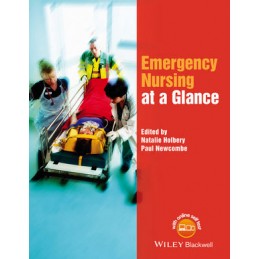- Reduced price

Order to parcel locker

easy pay


 Delivery policy
Delivery policy
Choose Paczkomat Inpost, Orlen Paczka, DHL, DPD or Poczta Polska. Click for more details
 Security policy
Security policy
Pay with a quick bank transfer, payment card or cash on delivery. Click for more details
 Return policy
Return policy
If you are a consumer, you can return the goods within 14 days. Click for more details
From the publishers of the market-leading at a Glance series comes a wide-ranging and succinct overview of the key concepts of emergency care. Emergency Nursing at a Glance uses the unique and highly visual at a Glance format to convey vital information quickly and efficiently, ensuring that nursing students have access to all the important topics they need for an emergency care placement. This highly visual, easy-to-read guide is the ideal companion for anyone entering fields involving urgent or unscheduled care.
•Includes all aspects of emergency care, including trauma, minor injury, triage processes, patient assessment, common emergency presentations, as well as legal, ethical and professional issues.
•Covers care of adults, children, and those with learning disabilities and mental health conditions
•Presented in the bestselling at a Glance format, with superb illustrations and a concise approach
Emergency Nursing at a Glance is an invaluable resource for nursing students, newly qualified nurses and other healthcare professionals working in emergency departments, urgent care centres, minor injury units and walk-in centres.
Data sheet
Contributors vii
Preface viii
Acknowledgements viii
About the Companion Website ix
Part 1 Initial patient assessment 1
1 The context of emergency nursing 2
2 Pre-hospital care 4
3 Triage 6
4 The ‘ABCDE’ approach 8
5 Track and trigger systems 10
6 Pain 12
Part 2 Airway and breathing 15
7 Airway assessment and management 16
8 Assessment of breathing 18
9 Oxygen therapy 20
10 Respiratory conditions 22
Part 3 Circulation 25
11 Assessment of circulation 26
12 Circulation interventions 28
13 Shock 30
14 12-lead electrocardiogram (ECG) 32
15 Cardiac arrhythmias 34
16 Acute coronary syndromes (ACS) 36
17 Heart failure 38
18 Advanced life support (ALS) 40
Part 4 Disability 43
19 Assessment of neurological function 44
20 The unconscious patient 46
21 Stroke 48
22 Seizures 50
23 Headache 52
Part 5 Emergency presentations and conditions 55
24 Abdominal pain 56
25 Gastrointestinal bleed 58
26 Genitourinary conditions 60
27 Acute kidney injury (AKI) 62
28 Diabetic emergencies 64
29 Obstetrics and gynaecology 66
Part 6 Poisoning and overdose 71
30 Poisoning: Assessment and management 72
31 Poisoning: Prescription and non-prescription drugs 74
32 Poisoning: Other substances 76
33 Alcohol misuse 78
Part 7 Infectious diseases 81
34 Infectious diseases 82
35 Notifiable diseases 84
36 Sexually transmitted infections (STI) 86
Part 8 Vulnerable patient groups 89
37 Domestic abuse 90
38 Sexual assault 92
39 The mental health patient in the emergency department (ED) 94
40 Risk assessment, self-harm and suicide 96
41 Common mental health problems 98
42 The patient with dementia 100
43 The patient with an intellectual disability 102
Part 9 Children in the emergency department 105
44 Children in the emergency department (ED) 106
45 Safeguarding children 108
46 Recognising the sick child 110
47 Common illnesses in children 112
48 Paediatric advanced life support 114
Part 10 Minor injuries and conditions 117
49 Minor injuries in children 118
50 Lower limb injuries 120
51 Upper limb injuries 122
52 Wounds 124
53 Eye conditions 126
54 Ear, nose and throat conditions 128
Part 11 Major Trauma 131
55 Trauma in context 132
56 Primary survey 134
57 Head and spinal injury 136
58 Chest trauma 138
59 Limb injuries 140
60 Abdominal and pelvic trauma 142
61 Massive haemorrhage 144
62 Burns 146
63 Trauma: Special circumstances 148
64 Trauma in children 150
65 Major incident 152
Part 12 Patient transfer and end of life care 155
66 Patient transfer 156
67 End of life care 158
Further reading/references 161
Index 165
